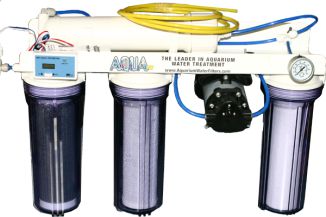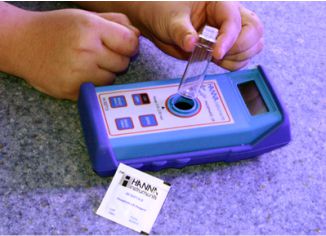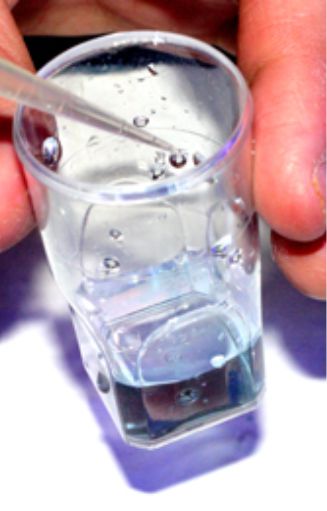Your Cart is Empty

The RODI Purifying Process
It is easy to purify your own tap water to produce ultra purified freshwater for you aquarium with a reverse osmosis (RO) and deionization (DI) unit. Many such units are available from many online sources, including a deluxe unit offered from us, and we will discuss some important points here about these units so you get maximum benefit from your RO/DI system and the purest water possible.
An RO/DI unit allows you to tap into your cold water supply line coming into your home and produces ultra purified water. The water is first run through a sediment filter that removes large debris particles, then a carbon cartridge that removes chlorine and other chemicals and odors, and then the RO membrane that removes over 90% of the impurities from your tap water.
RO membranes are available in different sizes that produce different amounts of purified water a day. The most popular RO membrane sizes are 50 or 100 gallons a day, but units are available to do many hundreds of gallons a day, we use a 1000 gallon per day membrane at our aquaculture facility. The water running through the RO membrane must be at 80 psi pressure to get the most pure water, this requires a booster pump that is usually not included as standard equipment on most RO/DI units. Running water through the RO membrane at lower pressure, such as the typical pressure of tap water, will not produce pure water and puts further burden on the DI resin to remove the remaining impurities thus exhausting it more rapidly and costing you more money in replacement DI cartridges! Get the booster pump and a pressure gauge to verify the water pressure going into the RO membrane, the pump will pay for itself over time in savings of DI resin cartridges because with the pump you produce more pure water going into the DI cartridge.
The RO water then is passed through a DI resin cartridge that removes the rest of the impurities. This now ultra purified water must be stored in food grade containers as it will cause leaching of chemicals from regular plastic containers. Food grade containers carry an NSF label imprinted on them and can be purchased from restaurant supply companies. It is recommended to have at least 20 gallons of purified freshwater on hand at all times and also a supply of mixed saltwater made from your purified freshwater ready in case a water change is needed.

TDS Monitor
DI water is ultra purified and to verify this you should use a Total Dissolved Solids (TDS) monitor. TDS monitors are inexpensive and will tell you how pure the water is coming out of your RO/DI unit. You should have a TDS reading of zero for your purified water, if not then you either have too low pressure of the water going through the RO membrane or the DI resin is exhausted and must be changed. The TDS monitor will not show you what is dissolved in your water, just that something is in that water that you don’ t want in your tank. A TDS reading above zero will lead to algae and coral problems in your tank because any level of impurities such as phosphate and nitrate will serve as food for algae and some impurities will adversely affect coral health and coloration. We sell Hanna Instruments brand TDS monitors for about $39 and these do well for most folks, the readout is in whole numbers. We also sell TDS monitors that are more sensitive and read in tenths and these are better for folks that are trying to achieve the ultimate in pure water, these monitors are Hanna Instruments brand PWT monitors and sell for about $89. We also sell RO/DI units that have TDS monitors built in that measure the water coming out of the RO membrane and the DI resin, plus these units also have built in booster pumps and are ready to hook up and get ultra purified water immediately without needing any other add-ons.
It is advisable to have extra DI resin cartridges on hand so you can change them when exhausted. RO membrane life will vary depending upon several factors and usually a simple indicator of when to change them is when water production significantly decreases, it is also advisable to have an extra membrane on hand for immediate replacement when needed. It seems that inevitably the membrane or DI resin will run out on a weekend when you planned to do some tank cleaning and a water change and you are left with no water and an RO/DI unit that can’ t produce any pure water. Get some extra cartridges and have them on hand to make your life easier!












